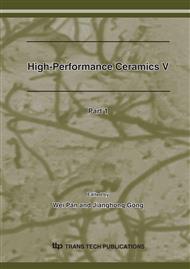p.686
p.688
p.691
p.694
p.697
p.701
p.704
p.707
p.710
Controlling Porosity and Pore Size Distribution of Alumina Ceramics in Consolidation Forming Process Using Modified Starches
Abstract:
Porous ceramic materials usually require an optimal porosity and pore-size distribution to maximize the yield of the required function. In the starch consolidation forming for porous ceramic materials, the porosity and pore size distribution are corresponding closely to the particle size and swelling property of starch. In order to control the porosity and pore size distribution of the porous alumina ceramics, different modified starches with different amounts were added to the alumina slurry with a 58 vol% alumina solid volume loading. The effects of different modified starches and their content on the rheological behavior of the alumina slurry and the porosity, pore size distribution, compressive strength and microstructure of the sintered body were investigated. The results indicated that alumina/starch composite slurry still maintain stable and plastic in suitable condition of slurry preparation. After drying and sintering, materials with ultimate porosities between 22.7 and 68.7% were obtained. The pore of the resulting materials distributed uniformly and the average size was varied from 10 to 40μm. It concluded that the average size was controlled by the modified starch type, amount and the degree of modification. When the amount of the modified starches was reached to 60 vol% the porosities of the sintered samples were varied from 63.5 to 68.7% with different modified starch type and their bending strength varied within the range of 24-32 MPa.
Info:
Periodical:
Pages:
697-700
Citation:
Online since:
February 2008
Authors:
Price:
Сopyright:
© 2008 Trans Tech Publications Ltd. All Rights Reserved
Share:
Citation:


